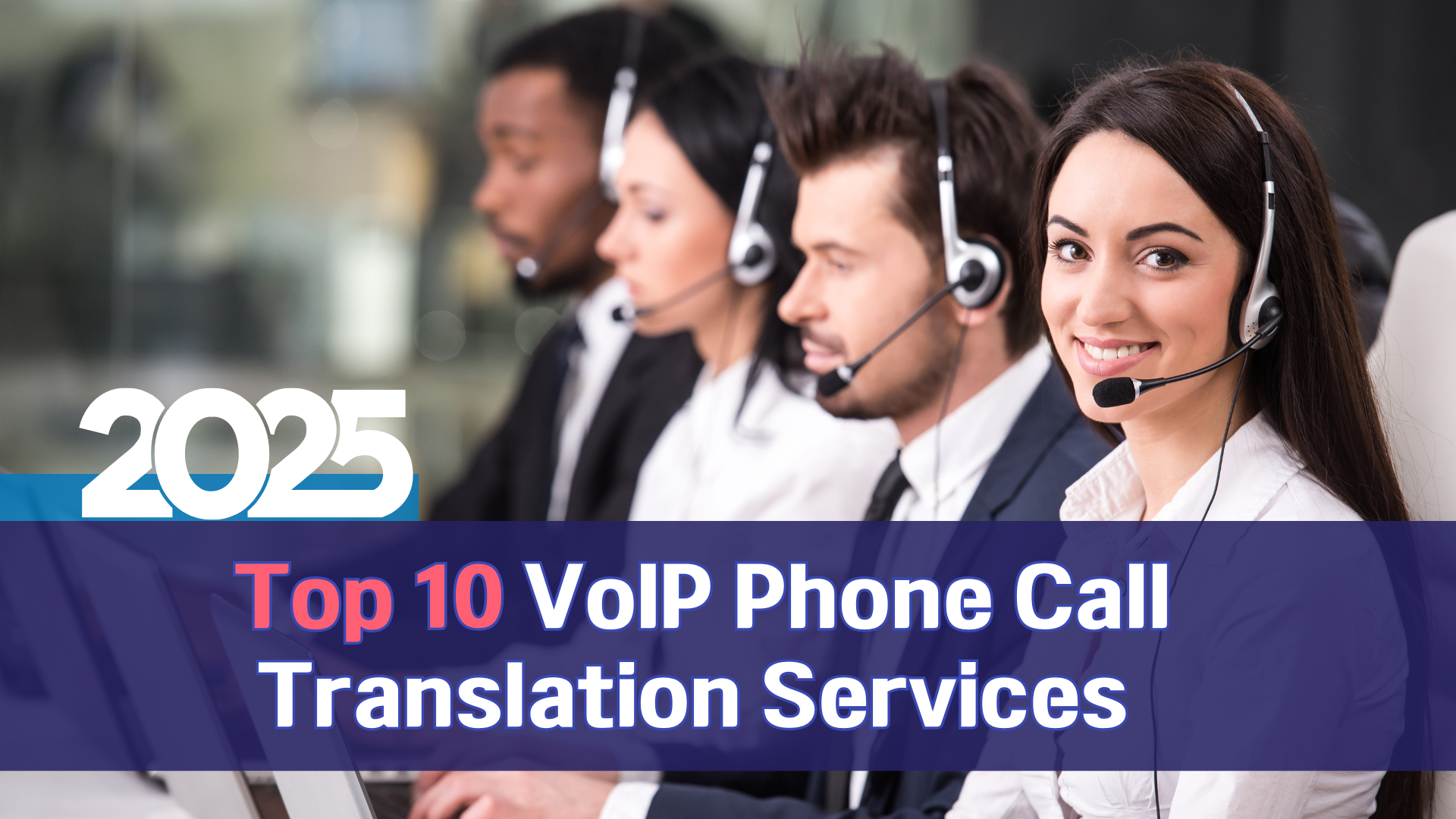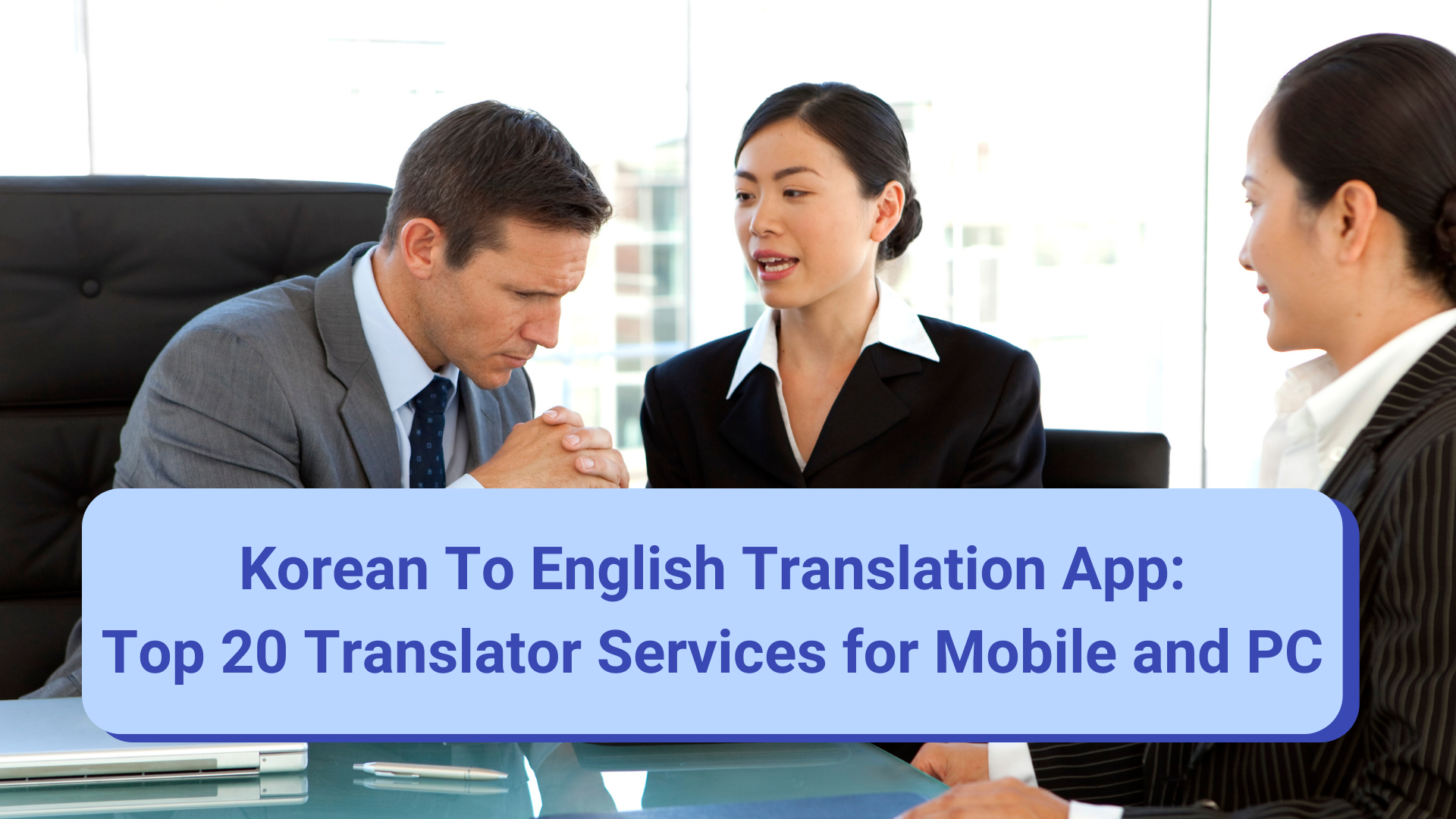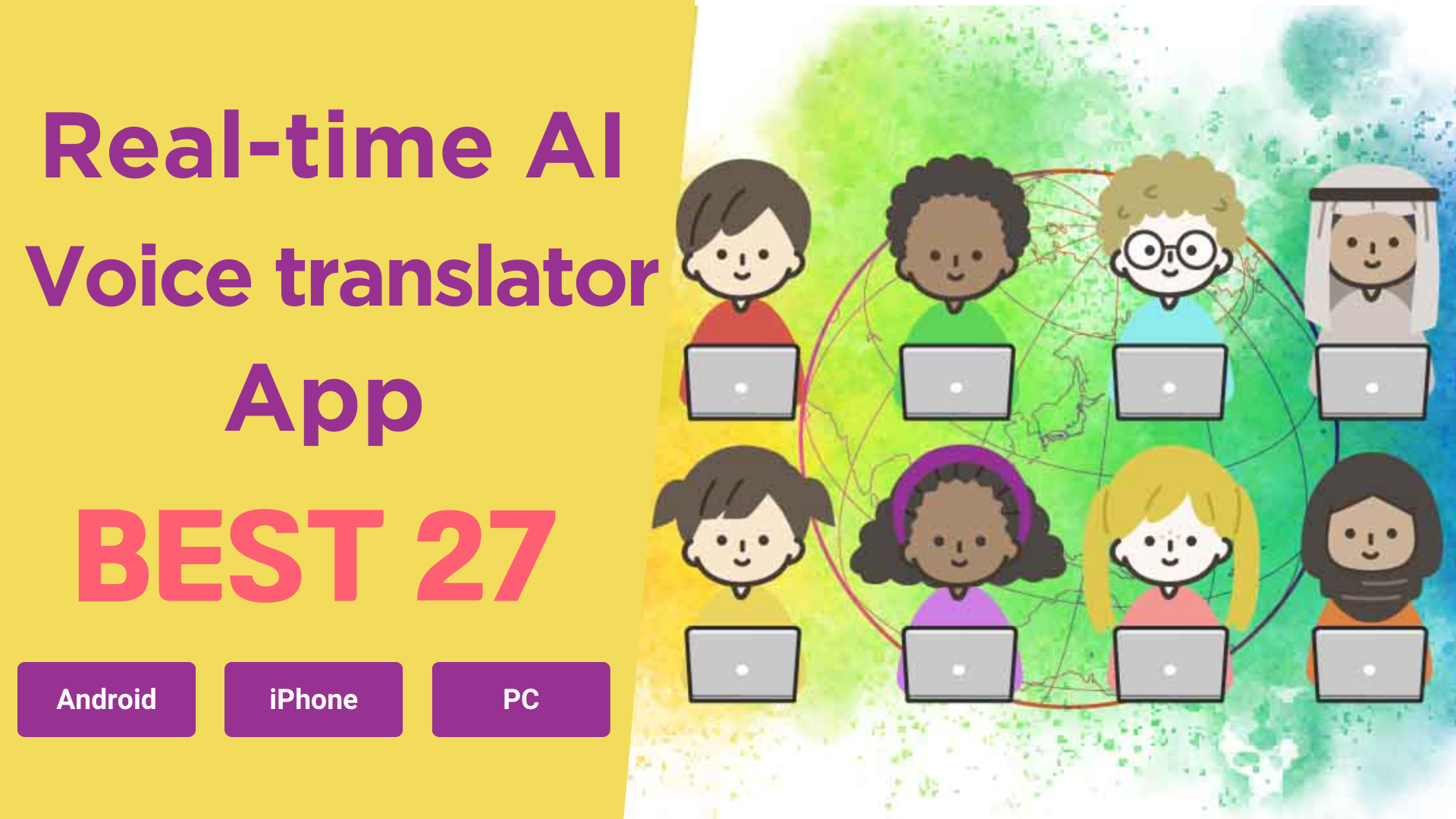目次
ToggleIntroduction
With the growing number of inbound tourists and the global expansion of businesses, the demand for multilingual support is higher than ever. Among the various communication channels, phone calls are particularly challenging due to their urgency and need for real-time response. Many on the front lines are finding that traditional methods involving human interpreters are reaching their limits.
In response, “VoIP Phone all Translation ” has emerged as a promising solution—automatically translating conversations in real time to streamline multilingual communication. In this article, we’ll explore how VoIP call translation works, the key benefits it offers, and introduce 10 leading solutions ideal for multilingual call centers.
What Is a Multilingual Call Center?

A multilingual call center is a customer support hub that assists not only in English but also in multiple languages such as Japanese, Chinese, and Korean.
In recent years, with the rise in inbound tourism and the global expansion of Japanese businesses, inquiries in foreign languages have increased across various sectors—tourism, healthcare, local governments, transportation, and infrastructure, to name a few. As a result, the adoption of multilingual call centers is rapidly gaining momentum.
Providing reliable service that transcends language and cultural barriers is essential for enhancing customer satisfaction and maintaining competitiveness in today’s global market.
The Connection Between Multilingual Call Centers and VoIP Call Translation
Traditionally, multilingual call centers have relied on human interpreters or hiring native-speaking staff to handle foreign language inquiries. However, this approach often involves high costs, scheduling challenges, and limited scalability.
This is where VoIP call translation comes into play. By leveraging real-time translation technology during phone conversations, VoIP solutions enable even Japanese-speaking agents to communicate effectively with non-Japanese-speaking customers. This not only reduces the need for dedicated multilingual staff but also enhances responsiveness and efficiency.
Integrating VoIP call translation into a multilingual call center can significantly lower operational costs, improve customer satisfaction, and provide a scalable solution for global communication needs.
When Are Multilingual Call Centers Most Effective?

Multilingual call centers play a crucial role in the following scenarios:
Inbound Tourism Support (Tourist Attractions, Hotels, Airports, etc.)
→ For assisting foreign visitors with directions, reservations, or emergency situations.Medical Support for Foreign Patients
→ Accurate communication is essential when gathering symptom details, scheduling appointments, or explaining insurance coverage.Multilingual Services at Local Governments and Public Offices
→ For handling administrative procedures, disaster response information, or daily life consultations for foreign residents.Customer Support for Cross-Border E-Commerce Sites
→ To handle purchases, returns, and shipping inquiries from international users smoothly.B2B Negotiations and Support for Global Enterprises
→ For providing product support and technical explanations in highly specialized fields when dealing with overseas partners.International Customer Support via VoIP Phone Systems
→ By integrating real-time translation into existing VoIP infrastructure, businesses can conduct seamless B2B/B2C phone calls with overseas clients—without overhauling current systems.
4 Common Approaches to Running a Multilingual Call Center

Multilingual call centers are typically operated using one or a combination of the following four approaches:
In-House Multilingual Staff
Hiring and training multilingual staff within the company. This allows for shared company culture and flexible response, but securing and retaining skilled personnel can be challenging.External Interpretation Support (Interpreter-Insertion Model)
Using a third-party interpreter during customer calls, often via three-way calling. This allows multilingual support without changing existing workflows but can result in slower response times.Outsourcing Entire Customer Support Operations (BPO Model)
Delegating all multilingual customer interactions to an external call center specializing in language support. While this ensures high-quality service, maintaining consistent communication and quality standards can be difficult.AI-Powered Automated Translation
Utilizing AI voice recognition and translation to respond in real time via voice or chat. This approach minimizes the need for human involvement, reducing costs while improving response speed. However, accuracy with technical terms or nuanced communication may require additional tuning.
Recently, voice translation features that integrate directly with VoIP systems have emerged, enabling real-time translation of phone conversations. These tools can be easily linked with cloud PBX or IP telephony platforms, making them especially accessible for small and medium-sized businesses.
Comparison of Multilingual Call Center Operation Models
Model | Advantages | Disadvantages |
|---|---|---|
In-House Multilingual Staff | Ensures alignment with company policies and allows for flexible, immediate responses. | High costs, difficulty in hiring qualified personnel, and the need to optimize staff allocation. |
External Interpreters Only | Professional interpreters can be connected on demand based on customer needs, providing high translation accuracy. | May cause call delays and carries potential risks in data sharing and confidentiality. |
Full Outsourcing (BPO) | Convenient for handling inquiries via chat or email with automatic translation; less time-sensitive. | Limited capability for handling complex cases; maintaining service consistency can be challenging. |
AI-Powered Translation | Low cost, 24/7 automated responses, and high scalability. | Risk of mistranslations due to poor audio quality; limited understanding of context and nuance. |
Benefits of Multilingual Contact Centers and VoIP Phone Translation Services
Introducing a multilingual call center brings far more advantages than simply enabling communication in foreign languages. It also contributes to improved customer service quality, greater operational efficiency, optimized costs, and enhanced global competitiveness. Here are some key benefits:
1. Improved Customer Satisfaction

Smooth communication in a customer’s native language provides a sense of reassurance, especially in stressful situations like making hotel reservations or visiting a hospital. Accurate and clear interaction reduces anxiety and leads to higher satisfaction levels. As a result, customers are more likely to leave positive feedback like “easy to understand” or “very attentive,” which in turn helps reduce complaints and response errors.
2. Increased Efficiency and Faster Response Times

With AI-powered translation solutions, operators can handle calls in multiple languages in real time—without the need to coordinate with interpreters or set up three-way calls. This significantly shortens handling time per inquiry and reduces the workload on operators, allowing them to respond to more customers efficiently.
These solutions can be seamlessly integrated with existing PBX and VoIP systems, eliminating the need for large-scale infrastructure changes. Additionally, features like automatic call transcription and logging help visualize communication data, supporting quality monitoring and internal training efforts.
3. Cost Reduction and Less Reliance on Specialized Staff

Traditional interpretation methods often require hiring or outsourcing language specialists for each language, leading to high costs. By adopting AI translation or BPO-style solutions, companies can reduce labor costs while building a more flexible, on-demand language support system. It also minimizes the time, effort, and risk involved in recruiting and training multilingual staff.
4. Strengthened Global Readiness

For companies targeting inbound tourism recovery or international market expansion, multilingual support is a critical competitive advantage. For example, e-commerce businesses that provide multilingual customer support can build trust with overseas customers and avoid missed sales opportunities.
In the public sector and healthcare, improved multilingual responsiveness enhances disaster response, public safety, and overall quality of life support for foreign residents.
6 Key Checkpoints When Choosing Multilingual Call Center Services
When considering the implementation of a multilingual call center, it’s essential to select a solution that aligns with your business operations and customer needs. Here are six crucial checkpoints to evaluate during the decision-making process:

1. Real-Time Translation Capability
- Can the system translate conversations instantly during a live call?
- In industries where timing is critical—such as healthcare, hospitality, and transportation—real-time performance is a top priority.
2. Accuracy of Speech Recognition and Translation
- Can the system handle industry-specific terminology, acronyms, or abbreviations?
- Does it accurately recognize regional accents, dialects, or speech variations? Low translation accuracy can lead to misunderstandings and service issues, so it’s important to verify how well the system performs in real-world scenarios.
3. Language Coverage
- How many and which languages are supported?
- Ensure the system can handle the languages most relevant to your customer base. The broader the language support, the more versatile your customer service can be.
4. Integration with Existing Systems
- Can the solution be integrated smoothly with your current CRM or call center platform?
- Check for available APIs and flexibility in customization. Seamless integration ensures a smoother rollout and better acceptance by internal teams without disrupting existing workflows.
5. Security and Privacy Compliance
- Is the solution compliant with domestic and international regulations such as GDPR or USA’s Act on the Protection of Personal Information?
- Where is customer data stored, and how long is it retained?This is especially critical in sectors handling sensitive information, such as healthcare, finance, and government.
6. Cost of Implementation and Operation
- Is the solution compliant with domestic and international regulations such as GDPR or Japan’s Act on the Protection of Personal Information?
- Where is customer data stored, and how long is it retained? This is especially critical in sectors handling sensitive information, such as healthcare, finance, and government.
By clarifying these factors in advance and testing the solution through demos or trial periods, you’ll be better positioned to make a confident, regret-free investment.
Recommended VoIP Phone Translation & Interpretation Services for Multilingual Call Centers
(1)App & Cloud-Based Solution
Zoom Phone
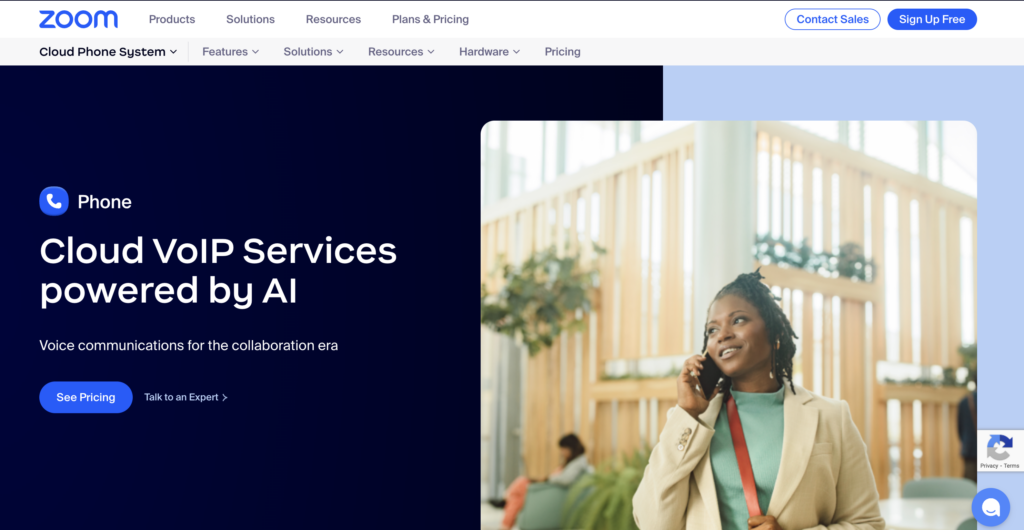
Zoom Phone is a cloud-based IP telephony service offered by Zoom, the company well-known for its video conferencing tools. Available in over 40 countries, it provides a global voice communication infrastructure and is increasingly being adopted for multilingual business support.
While Zoom Phone itself does not offer built-in translation features, it supports a wide range of third-party integrations through the Zoom App Marketplace and APIs. This allows organizations to incorporate real-time translation or interpreter support via add-ons. For instance, by integrating AI-powered tools like Interprefy or Lingmo Translate, companies can build a multilingual call center environment based on Zoom Phone.
A key advantage is its seamless integration with existing Zoom products such as Zoom Meetings and Zoom Rooms, enabling unified communication across call center operations, internal meetings, and international business discussions.
Supported Languages: Expandable via integrations (e.g., English, Chinese, Spanish, etc.)
Translation Type: AI-based translation or live interpreters (real-time) depending on integration
Key Features: Cloud PBX, call recording, call log management, third-party service integration
Use Cases: Global enterprises, educational institutions, healthcare providers, and government agencies
Pricing: Varies by country and plan (Starting from approx. ¥1,500/month per user; translation services priced separately)
Recommended for:
→ Companies already using Zoom in their operations and looking to strengthen multilingual voice support
→ Medium to large organizations seeking to customize their translation solutions through flexible API integrations
Offical Site:https://www.zoom.com/en/products/voip-phone/
Microsoft Teams Phone

Microsoft Teams Phone extends the calling capabilities of Microsoft Teams to create a cloud-based business phone environment. It allows businesses to unify internal and external voice communications within Teams, while also supporting integration with various PBX systems and SIP trunks, enabling smooth transitions from traditional telephony setups.
Although Microsoft Teams Phone does not include built-in AI translation features, it can be integrated with Microsoft Azure Cognitive Services to enable customized workflows for speech recognition, translation, and transcription. Additionally, third-party interpretation services—such as Interprefy or Language Weaver—can be incorporated to build a multilingual call environment.
The platform also offers Conversation Intelligence features, including call recording, transcription, and translation, enabling businesses to overcome language barriers and gain deeper insights across global sales, customer support, and other voice-based interactions.
Supported Languages: Expandable via integrations (e.g., English, Spanish, Chinese, etc.)
Translation Type: AI translation via Azure or live interpreters (real-time or post-call)
Key Features: Voice calling, call recording & transcription, cloud PBX, conversation analytics, system integration
Use Cases: Large enterprises, government agencies, educational institutions, healthcare providers
Pricing: Varies by Microsoft 365 license (Teams Phone Standard from approx. ¥1,199/month per user)
Recommended for:
→ Companies already operating within a Microsoft 365 environment
→ Organizations seeking customizable multilingual support through AI and translation API integration
Cisco Webex Calling
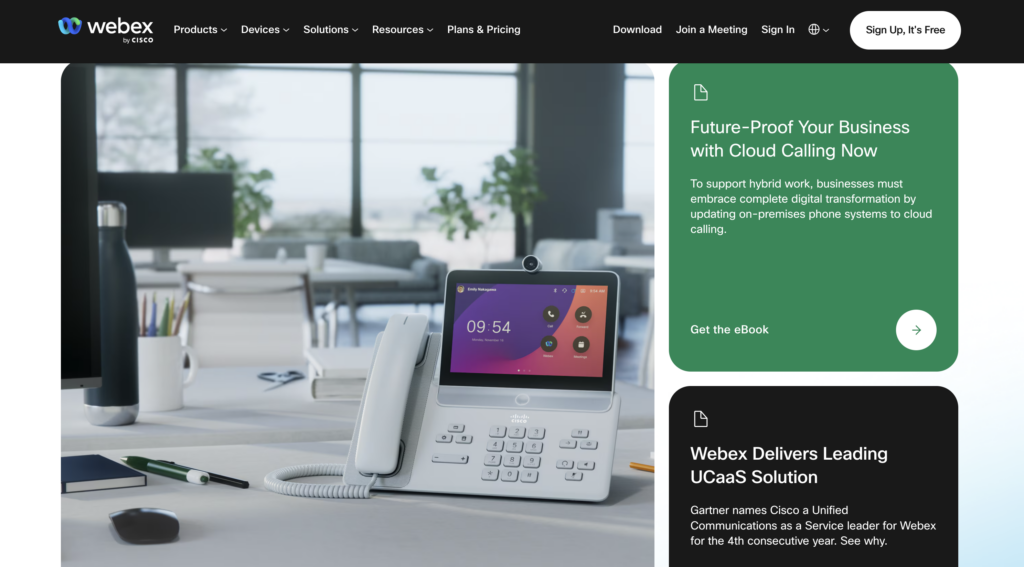
Cisco Webex Calling is a cloud-based business IP phone service offered by Cisco, designed with enterprise-grade security and scalability. With a strong global track record, it serves as a reliable solution for medium to large organizations transitioning to cloud-based PBX systems.
The platform includes features such as voice calling, voicemail, auto-attendant, call queues, and user management. By integrating with Cisco Webex’s meetings and messaging tools, it creates an ideal communication foundation for hybrid work environments.
For multilingual support, pairing with Webex Contact Center enables a robust environment combining voice bots, real-time transcription, and third-party translation services. Through the Webex App Hub, users can integrate tools like Google Cloud Translation or Interprefy to expand language support.
Supported Languages: Expandable via third-party integrations (e.g., English, Japanese, Spanish, Chinese, etc.)
Translation Type: External AI translation or interpreter integration (real-time or text-based)
Key Features: Cloud PBX, call recording, auto-attendant, integration with meetings and messaging, translation add-ons
Use Cases: Global enterprises, government bodies, educational institutions, and industries such as healthcare and finance
Pricing: Varies by plan (Webex Calling Essentials from $8.95/month per user; translation services priced separately)
Recommended for:
→ Medium to large enterprises with global operations in mind
→ Organizations seeking a secure, multilingual-ready cloud PBX
→ Existing Webex users looking to enhance voice translation and contact center capabilities
Official Site: https://www.webex.com/suite/enterprise-cloud-calling.html
Dialpad
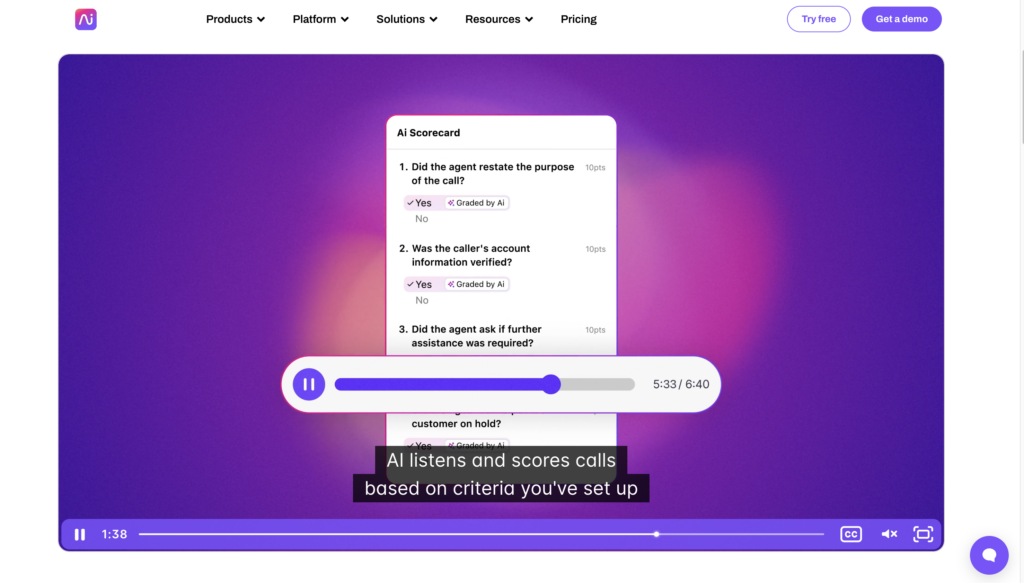
Dialpad is a next-generation, AI-powered cloud business phone solution originating from the U.S. While designed for global use, it also emphasizes multilingual support, including Japanese. The platform offers a unified suite of services—voice calls, video conferencing, chat, and contact center functions.
Its standout feature is real-time AI speech recognition with live transcription and conversation summaries. During a call, conversations are transcribed in real time by AI, which can then be used for translation, meeting documentation, or internal knowledge sharing. By integrating with external APIs like Google Translate or DeepL, the platform also enables multilingual voice support.
The Dialpad AI Contact Center further enhances multilingual customer support by offering features such as automatic response suggestions based on the inquiry and real-time FAQ prompts during calls—empowering agents with AI-driven assistance.
Supported Languages: Japanese, English, Chinese, Spanish, French, and more (for speech recognition and translation)
Translation Type: AI speech recognition + real-time transcription + external translation integrations (e.g., DeepL, Google)
Key Features: AI transcription, conversation summaries, CRM integration, real-time FAQ suggestions, contact center functionality
Use Cases: Companies like Google, Xero, WeWork, and various Japanese IT firms
Pricing: From $15/month (Standard); AI Contact Center priced separately (Japanese version available)
Recommended for:
→ Companies looking to streamline multilingual communication through AI-powered call transcription and analysis
→ Medium to large organizations building global call center and customer support infrastructure
→ Teams aiming to enhance knowledge sharing and visibility of call data across departments
Official Site: https://www.dialpad.com/
AI Phone
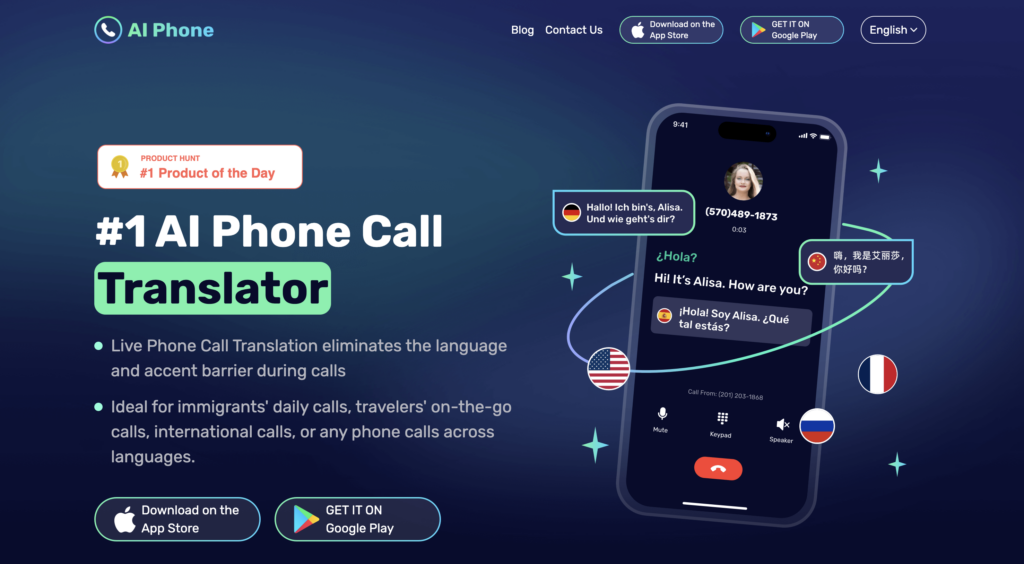
AI Phone is a smartphone-based IP telephony app that leverages AI-driven voice translation technology. Supporting over 90 languages—including Japanese—it enables smooth communication between speakers of different languages by translating calls in real time and synthesizing translated speech during the conversation. The app also offers automatic transcription and AI-generated call summaries.
Users can obtain a phone number directly within the app, making it easy to initiate international calls without additional hardware or setup.
Supported Languages: 90+ languages including Japanese, English, Chinese, Korean, Vietnamese, Spanish, and more
Translation Type: AI speech recognition + real-time translation + speech synthesis
Key Features: Real-time call translation, AI-powered call summaries, call recording, automatic transcription
Use Cases: Inbound tourism services, international sales, language learning—used by individuals and businesses alike
Pricing: Subscription and pay-as-you-go options available (e.g., from ¥980/month)
Recommended for:
→ Small businesses and solo entrepreneurs seeking an affordable, quick solution for multilingual phone calls
→ B2C communication with overseas clients, or high-speed response environments such as tourism and hospitality
VoicePing
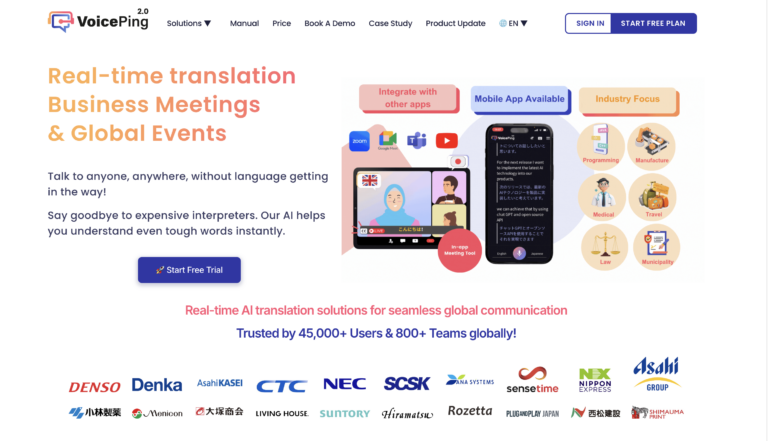
VoicePing is a real-time voice translation solution developed in Japan, currently focused on providing multilingual simultaneous interpretation for video conferencing and online meetings. It integrates with existing platforms such as Zoom and Google Meet, offering real-time voice translation and subtitle display to facilitate seamless communication across languages.
Looking ahead, VoicePing plans to expand with a feature called “VoicePing IP”, which will enable real-time voice translation for both phone and PC-based calls. With this system, agents can speak in their native language while the recipient hears an automatically translated version. All conversations will be transcribed and summarized by AI, offering a streamlined and intelligent communication experience.
This evolution is expected to significantly reduce traditional translation and interpretation costs while dramatically enhancing the speed and quality of multilingual customer support.
Supported Languages: 45 languages including Japanese, English, Chinese, Korean, and more
Translation Type: Currently: AI voice translation for video meetings; Coming soon: AI voice call translation (VoIP + PC)
Key Features: Real-time subtitles, speaker identification, meeting transcription, AI-generated summaries
Use Cases: IT companies, manufacturers, educational and research institutions
Pricing: Free plan available; Paid plans start at ¥4,125/month; VoIP translation currently in beta
Recommended for:
→ Businesses and academic institutions seeking real-time translation in global meetings
→ Organizations planning to build a multilingual phone support system in the near future
→ Early adopters looking for next-gen communication tools with automated translation, transcription, and summarization
Official Website: https://voice-ping.com/en/
Ooma Office

Ooma Office is a cloud-based VoIP phone service designed primarily for small to medium-sized businesses. Known for its simple user interface, reliability, and excellent cost performance, it is highly rated in the U.S. market. The service covers essential business phone features such as number provisioning, extension setup, auto-attendant, and mobile app integration—making it easy to deploy even without technical expertise.
While real-time translation is not natively included, Ooma can be integrated with third-party voice translation tools (like Zoom or Microsoft Teams) or used with recording + transcription + external translation APIs to create custom multilingual solutions.
The advanced Ooma Enterprise plan offers further flexibility with SIP trunking, CRM integration, and API support, making it a suitable base for developing a future-ready multilingual call system.
Supported Languages: Primarily English; multilingual support available via third-party integrations
Translation Type: Transcription + external translation, or third-party platform integration
Key Features: Cloud PBX, auto-attendant, mobile app support, voicemail forwarding, SIP trunking
Use Cases: U.S.-based small businesses, retail shops, medical/legal offices, restaurants
Pricing: From $19.95/month; tiered plans based on features
Recommended for:
→ Small businesses and storefronts looking to implement IP telephony at low cost
→ Offices seeking a simple, reliable business phone setup
→ Organizations planning for future multilingual support via third-party tool integration
Official Website: https://www.ooma.com/office/
(2)Human Interpreter-Based Solutions
CyraCom
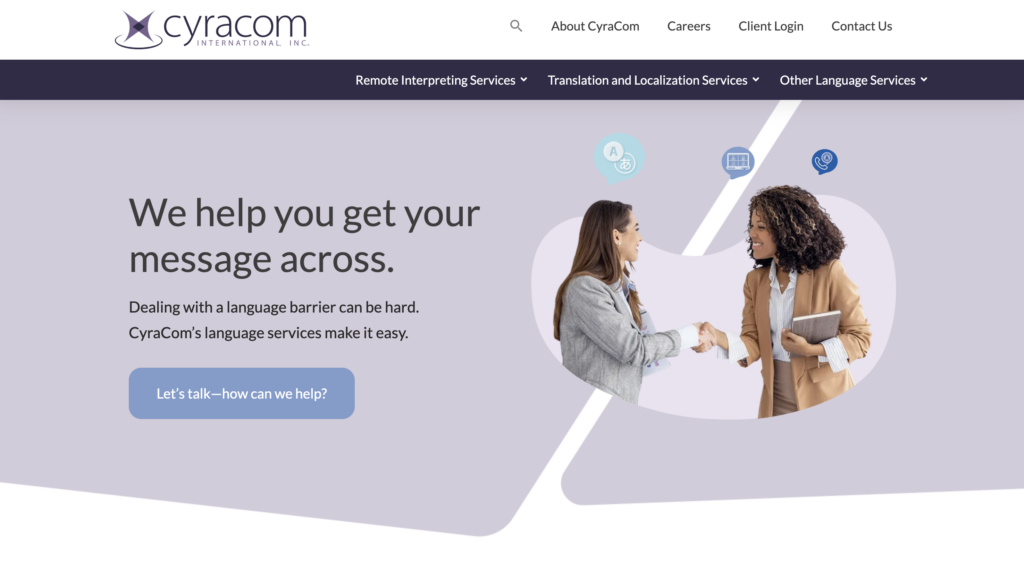
CyraCom is a leading provider of phone and video interpretation services, specializing in professional, HIPAA-compliant interpretation for the healthcare, insurance, and customer service sectors. CyraCom offers services in over 200 languages, connecting clients to trained interpreters through secure and reliable communication channels.
Calls can be initiated through dedicated interpreter phone lines or integrated software tools, making it easy for organizations to add language support without major infrastructure changes.
Supported Languages: 250+ languages including Spanish, Mandarin, Vietnamese, Russian, French, and more
Translation Type: On-demand human interpretation via phone and video platforms
Key Features: HIPAA compliance, fast interpreter connection, healthcare-focused training
Use Cases: Hospitals, clinics, insurance firms, contact centers, public health organizations
Pricing: Usage-based pricing; enterprise plans available
Recommended for:
→ Medical institutions that require certified, HIPAA-compliant interpretation
→ Organizations seeking scalable, secure, and healthcare-optimized language support
Official Website: https://www.cyracom.com/
Propio Language Services
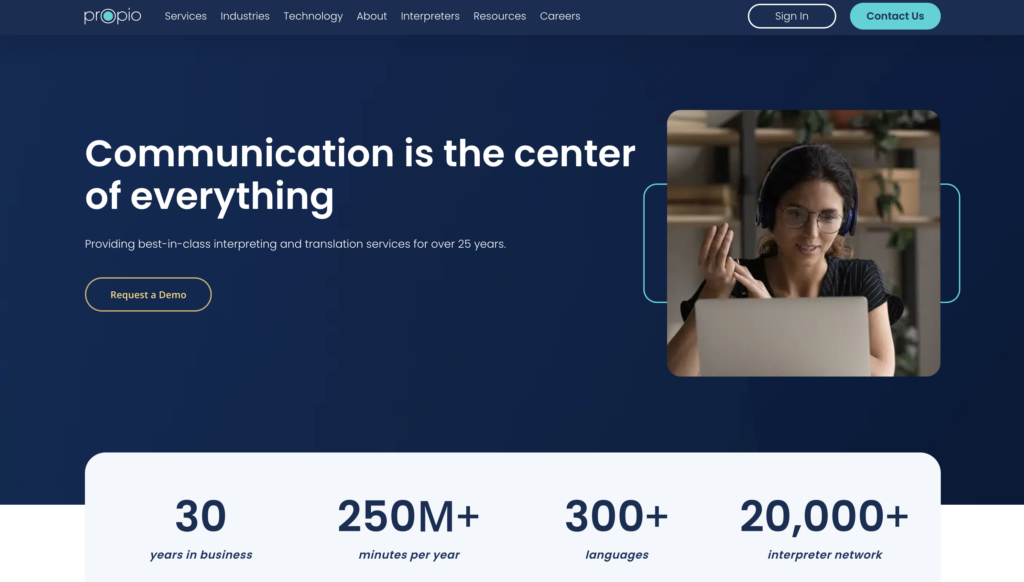
Propio Language Services offers a wide range of human interpreter-based solutions including over-the-phone interpretation (OPI), video remote interpretation (VRI), and on-site interpretation in more than 300 languages. The services are available 24/7, catering to industries like healthcare, emergency response, government, finance, and education.
Organizations can instantly connect with professional human interpreters via secure and scalable three-way calling platforms. The company emphasizes fast connection times, HIPAA compliance, and industry-specific interpreter training.
upported Languages: 300+ languages including Spanish, Mandarin, Arabic, Vietnamese, Russian, and more
Translation Type: On-demand human interpretation via phone, video, and on-site appointments
Key Features: 24/7 availability, sub-10-second connection time, HIPAA-compliant, industry-trained interpreters
Use Cases: Hospitals, 911 call centers, public agencies, financial services, educational institutions
Pricing: Per-minute or customized enterprise pricing based on usage volume
Recommended for:
→ Emergency responders and healthcare providers requiring rapid interpreter access
→ Government or enterprise clients looking for scalable, secure multilingual support
Official Website: https://propio.com
LanguageLine Solutions
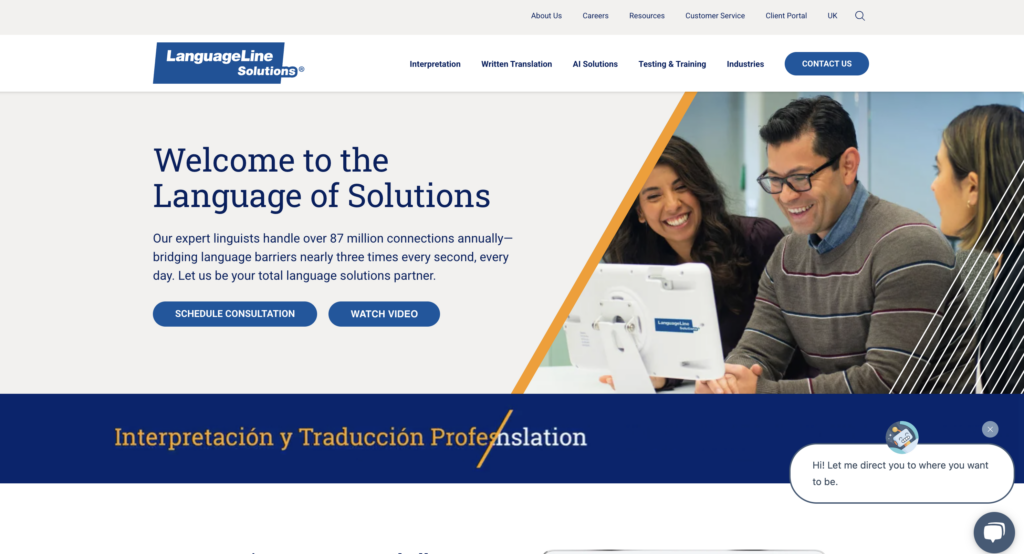
LanguageLine Solutions is one of the world’s largest interpretation service providers, headquartered in the United States. The company offers on-demand phone interpreting, video interpreting, and document translation in over 240 languages. Its phone interpretation service is available 24/7/365, connecting users with professional human interpreters instantly—widely used across sectors such as healthcare, government, finance, and education.
All it takes is a phone call and a language selection to be instantly connected to a qualified interpreter via three-way calling. All conversations are strictly protected under confidentiality agreements and handled within a secure environment.
Supported Languages: 240+ languages including English, Spanish, Chinese, Arabic, Japanese, and more
Translation Type: On-demand human interpretation via three-way phone calls
Key Features: 24/7 interpreter access, industry-specific professionals, secure call handling
Use Cases: U.S. government agencies, hospitals, insurance companies, educational institutions, banks
Pricing: Pay-per-minute billing; varies by contract and usage
Recommended for:
→ Healthcare providers and government agencies requiring fast, high-accuracy interpretation
→ Enterprises that prioritize proven quality and reliability in phone interpretation
Official Website: https://www.languageline.com/
Conclusion
With the rise in inbound tourism and the global expansion of business, multilingual support has become an essential challenge for both companies and public institutions. In particular, phone-based communication demands immediacy and accuracy—making AI-powered VoIP translation solutions an increasingly attractive option.
In this article, we’ve provided a comprehensive overview—from the fundamentals of multilingual call centers and the comparison of operational models, to real-world application scenarios and our top picks for both AI-based translation tools and human interpretation services.
As AI technology and telecommunications infrastructure continue to evolve, we can expect even more natural and accurate real-time call translation in the near future. Regardless of industry or company size, selecting the right solution tailored to your needs can dramatically enhance your customer communication capabilities in today’s globalized world.
About VoicePing
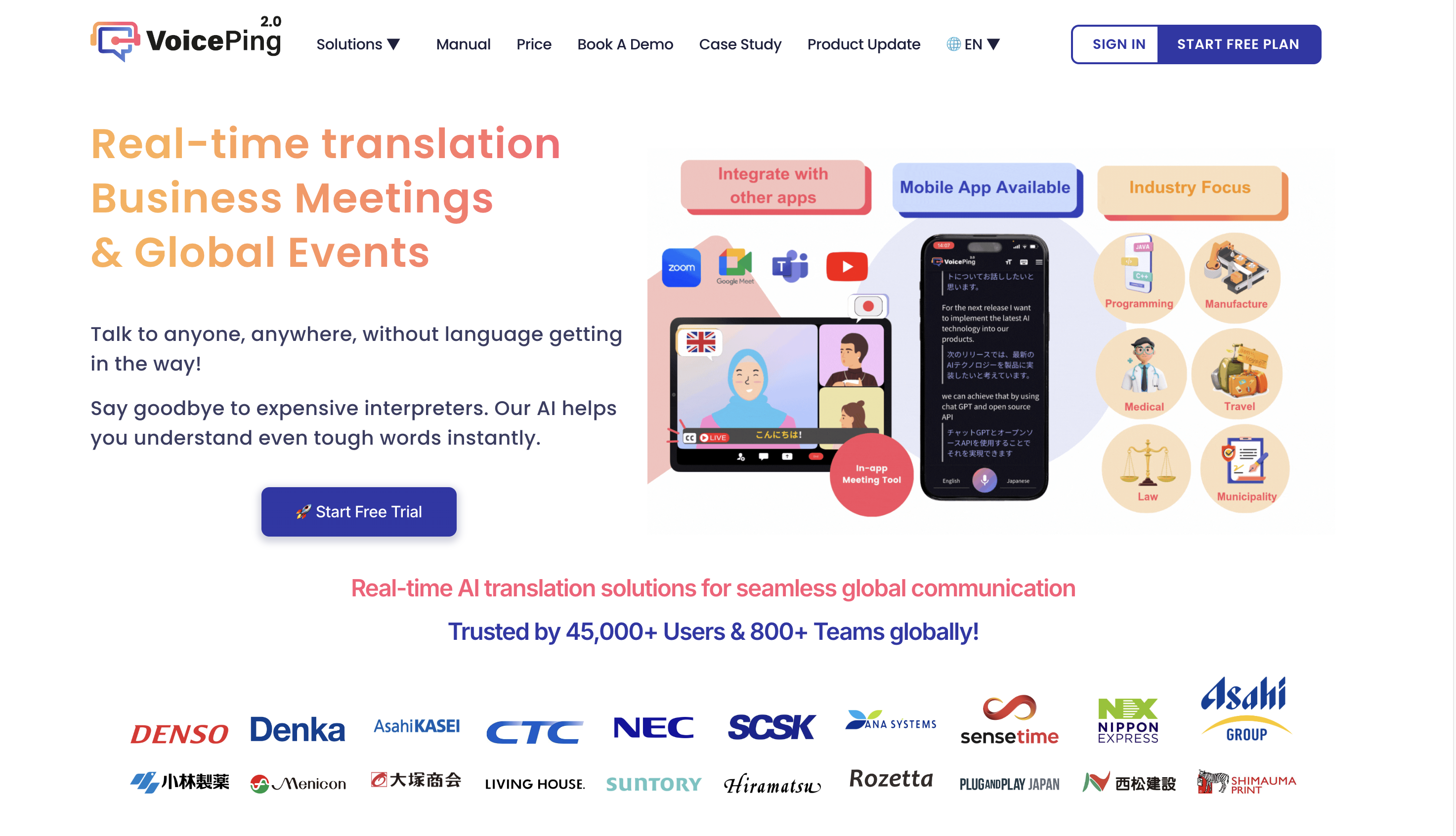
For businesses seeking a smooth and effective voice translation experience, VoicePing is one of the top recommended tools.
VoicePing comes with built-in meeting and voice translation features, eliminating the need to juggle multiple apps or integrate external tools. Its proprietary speech-to-text and translation learning models ensure high accuracy, fast processing, and seamless meeting transcription—making it a powerful solution for global business communication.
By leveraging VoicePing’s AI-powered voice translation, you can enhance global collaboration, share knowledge with a broader audience, and drive better business outcomes.
For more details on VoicePing’s services and solutions, please visit the official website.
Contact our support team for personalized consultations or any other inquiries.

